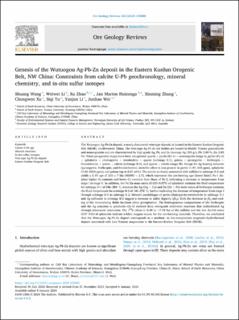| dc.contributor.author | Wang, Shuang | |
| dc.contributor.author | Li, Weiwei | |
| dc.contributor.author | Zhao, Xu | |
| dc.contributor.author | Huizenga, Jan Marten | |
| dc.contributor.author | Xinming, Zhang | |
| dc.contributor.author | Xu, Chongwen | |
| dc.contributor.author | Yu, Siqi | |
| dc.contributor.author | Li, Yanjun | |
| dc.contributor.author | Wei, Junhao | |
| dc.date.accessioned | 2024-01-22T11:49:33Z | |
| dc.date.available | 2024-01-22T11:49:33Z | |
| dc.date.created | 2024-01-13T18:32:54Z | |
| dc.date.issued | 2024 | |
| dc.identifier.citation | Ore Geology Reviews. 2024, . | |
| dc.identifier.issn | 0169-1368 | |
| dc.identifier.uri | https://hdl.handle.net/11250/3113078 | |
| dc.description.abstract | The Wutuogou Ag-Pb-Zn deposit, a newly discovered vein-type deposit, is located in the Eastern Kunlun Orogenic Belt (EKOB), northwestern China. The vein-type Ag-Pb-Zn ore bodies are hosted in Middle Triassic granodiorite and monzogranite and are characterized by high-grade Ag, Pb, and Zn (average Ag: 293 g/t, Pb: 3.00 %, Zn: 2.85 %). Three paragenetic stages have been recognized: quartz + pyrite (Py-1) + arsenopyrite (stage I), pyrite (Py-2) + sphalerite + chalcopyrite + tetrahedrite + quartz (substage II-1), galena + pyrargyrite + freibergite + freieslebenite + quartz + calcite (substage II-2), and quartz + calcite (stage III). Except for Ag-bearing minerals (pyrargyrite, freibergite, and freieslebenite), invisible silver is also present in pyrite (1.91–165 ppm), sphalerite (3.86–8806 ppm), and galena (up to 0.21 wt%). The calcite is closely associated with sulfides in substage II-2 and yields a U-Pb age of 210 ± 7 Ma (MSWD = 2.7), which represents the ore-forming age (lower limit). Py-1 displays higher As contents and lower Co contents than those of Py-2, indicating a decrease in temperature from stage I to stage II. In addition, the Fe/Zn mass ratios (0.025–0.075) of sphalerite estimate the fluid temperature for substage II-1 of 246–284 ◦C, whereas the Ag/(Ag + Cu) and Zn/(Zn + Fe) mole ratios of freibergite estimate the fluid temperature for substage II-2 of 140–270 ◦C, further indicating the decrease of temperature from stage I through substage II-1 to substage II-2. Mineral assemblages of pyrite-chalcopyrite-tetrahedrite in substage II-1 and Ag-sulfosalts in substage II-2 suggest a decrease in sulfur fugacity (fS2). Both the decrease in fS2 and cooling of the mineralizing fluids facilitate silver precipitation. The heterogeneous compositions of the freibergite and the Ag zonation in sphalerite (Sp-1) resulted from retrograde solid-state reactions that redistributed Ag through microscale exsolution. The δ34S values (+5.49 to +7.78 ‰) of the sulfides and the low Zn/Cd ratios (107–195) of sphalerite indicate a felsic magma source for the ore-forming materials. Therefore, we concluded that the Wutuogou Ag-Pb-Zn deposit corresponds to a medium- to low-temperature magmatic-hydrothermal deposit associated with Late Triassic magmatism in the Eastern Kunlun Orogenic Belt (EKOB) | |
| dc.description.abstract | Genesis of the Wutuogou Ag-Pb-Zn deposit in the Eastern Kunlun Orogenic Belt, NW China: Constraints from calcite U-Pb geochronology, mineral chemistry, and in-situ sulfur isotopes | |
| dc.language.iso | eng | |
| dc.title | Genesis of the Wutuogou Ag-Pb-Zn deposit in the Eastern Kunlun Orogenic Belt, NW China: Constraints from calcite U-Pb geochronology, mineral chemistry, and in-situ sulfur isotopes | |
| dc.title.alternative | Genesis of the Wutuogou Ag-Pb-Zn deposit in the Eastern Kunlun Orogenic Belt, NW China: Constraints from calcite U-Pb geochronology, mineral chemistry, and in-situ sulfur isotopes | |
| dc.type | Peer reviewed | |
| dc.type | Journal article | |
| dc.description.version | publishedVersion | |
| dc.source.pagenumber | 17 | |
| dc.source.journal | Ore Geology Reviews | |
| dc.identifier.doi | 10.1016/j.oregeorev.2024.105880 | |
| dc.identifier.cristin | 2225858 | |
| cristin.ispublished | true | |
| cristin.fulltext | original | |
| cristin.qualitycode | 1 | |
